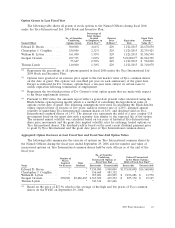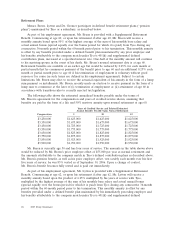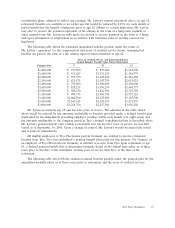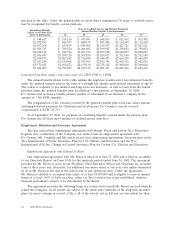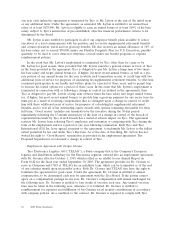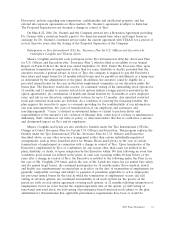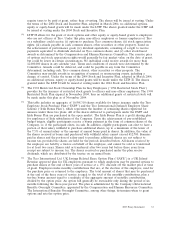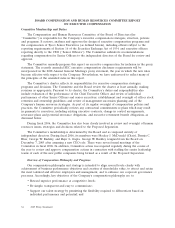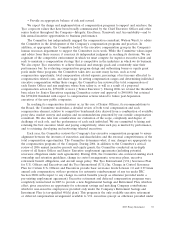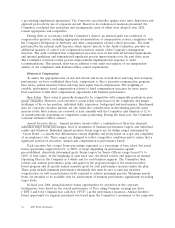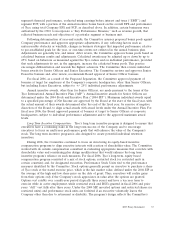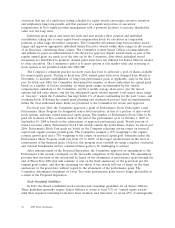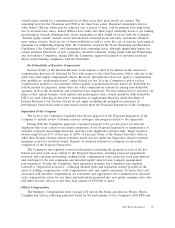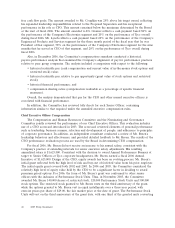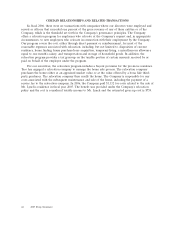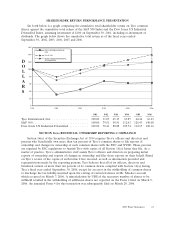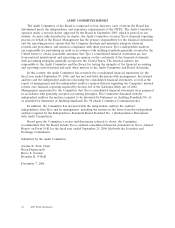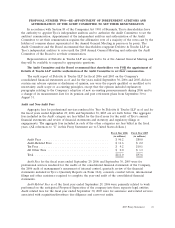ADT 2006 Annual Report Download - page 47
Download and view the complete annual report
Please find page 47 of the 2006 ADT annual report below. You can navigate through the pages in the report by either clicking on the pages listed below, or by using the keyword search tool below to find specific information within the annual report.• Provide an appropriate balance of risk and reward.
We expect the design and implementation of compensation programs to support and reinforce the
Tyco corporate values that have been broadly communicated by the Chief Executive Officer and other
senior leaders throughout the Company—Integrity, Excellence, Teamwork and Accountability—and to
link annual incentive opportunities to business performance.
The Committee has independently engaged the compensation consultant, Watson Wyatt, to advise
the Committee in the development of the Company’s compensation programs and practices. In
addition, as appropriate, the Committee looks to the executive compensation group in the Company’s
human resources department to support the Committee in its work. While the Committee values input
and advice from these sources, it exercises its independent judgment in reaching its decisions. We are
cognizant of the competitive environment in which we must compete for superior executive talent and
seek to maintain a compensation strategy that is competitive in the industries in which we do business.
We also expect Tyco executives to achieve financial and strategic goals and consistently raise their
performance bar. In evaluating compensation program design and authorizing bonus or equity grant
pools under these programs, the Committee takes into account many factors, such as total
compensation opportunity, total compensation related expense, percentage of net income allocated to
compensation related costs, and share usage. In setting compensation ranges and determining individual
executive compensation within those ranges, the Committee has reviewed the total compensation of
each Senior Officer and any employee whose base salary is, or will as a result of a proposed
compensation action be, $350,000 or more (‘‘Senior Executive’’). During 2006, we revised the threshold
base salary for Senior Executives requiring Committee review and approval to $400,000, but retained
the $350,000 threshold with respect to compensation actions related to future post-Separation
executives of the new public companies.
In reaching its compensation decisions or, in the case of Senior Officers, its recommendations to
the Board, the Committee undertakes a detailed review of both total compensation and each
compensation element, relative to competitive benchmark data derived from a combination of available
proxy data, market surveys and analysis and recommendations presented by our outside compensation
consultant. We also take into consideration our evaluation of the scope, complexity and degree of
challenge of each role, and the performance of each such individual. We are committed to hiring and
retaining the best executive talent and paying competitively, when such pay is merited by performance,
and to retaining, developing and motivating talented executives.
Each year, the Committee reviews the Company’s key executive compensation programs to assure
alignment between the interests of executives and shareholders and the external competitiveness of the
total compensation opportunities. The Committee determines what, if any, changes are appropriate in
the compensation programs of the Company. During 2006, in addition to the Committee’s critical
review of 2006 annual incentive payouts and equity grants, the Committee conducted an in-depth
review of all Senior Officer and Senior Executive employment agreements (including potential
severance obligations under such agreements). During 2006, the Committee also reviewed existing stock
ownership and retention guidelines, change in control arrangements, severance plans, executive
retirement benefit obligations, and aircraft usage policy. The Tyco International (U.S.) Severance Plan
for U.S. Officers and Executives and the Tyco International (U.S.) Inc. Change in Control Severance
Plan for Certain U.S. Officers and Executives provide basic severance levels between 1.0 and 2.99 times
annual cash compensation, with no provision for automatic reimbursement of any tax under IRC
Section 280G with respect to any change in control benefits (except as otherwise provided under a
pre-existing employment agreement). Executive retirement and deferred compensation programs were
completely restructured in 2005 to provide a new Supplemental Savings and Retirement Plan, which in
effect, gives executives an opportunity for retirement savings and matching Company contributions
which for non-executive employees is provided only under the Company’s Retirement Savings and
Investment Plan (a tax-qualified 401(k) plan). This program is the only available executive retirement
or deferred compensation arrangement available to U.S. executives (except as otherwise provided under
2007 Proxy Statement 35


